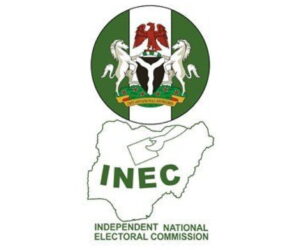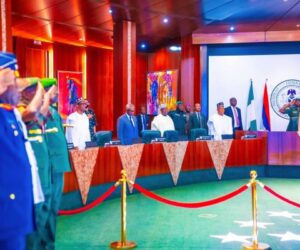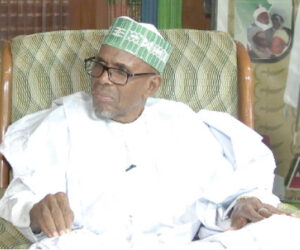The Kanem-Bornu Empire physically crumbled at the end of the 19th century, but its spirit still struggles to live on in history.
For over a millennium, it wielded immense military, political, economic and socio-cultural powers, with which it built an enviable degree of fame and pedigree in both its physical and spiritual being in the annals of the Central Sudan.
Now in its defunct physical state, it is only struggling to sustain that millennial spirit in the political and socio-cultural settings of modern nationhood in the four Lake Chad basin countries of Nigeria, Niger, Chad and Cameroon.
SPONSOR AD
In this region, the enviably solid and proud people now cohabit with other ethnic nationalities as bonafide and integral citizens.
Many historians say the Kanem-Bornu Empire is one of the longest-lasting empires in African history, which emerged around the 8th century in the Kanem region (present-day Chad) and later shifted to Borno (present-day Nigeria).
According to them, it was a trans-Saharan empire famous for its trade, particularly along the trans-Saharan trade routes and its enduring state structure.
However, the Zanna Gargamma of Borno, (Custodian of history of the Shehu’s palace) Dr. Babagana Kachalla, said the compound word Kanem-Bornu was derived from the geographical location of the territories of the Kanem and Borno Empire.
“The use of the hyphenated term, Kanem-Bornu, was derived from the territories that are situated to the northeastern part of Lake Chad and the southeastern part of Lake Chad.
“Kanem is situated in the northeastern part of Lake Chad in present day Chad Republic. Now, Borno is situated in the southeastern part of Lake Chad, with a greater part of its territories in present day Nigeria,” Kachallah explained.
Rise and fall of Kanem-Bornu
The foundation and early history of the Kanem–Bornu Empire is quite scanty. The empire is, however, said to have been founded around the year 700, albeit, according to some sources, it may have been established centuries earlier or later.
During its foundation period, the ruling Duguwa dynasty, ruled from Njimi, was founded as the empire’s capital in the Kanem region.
By the 11th century, the Duguwa were uprooted by the Saifawa dynasty and, subsequently, the empire converted to Islam.
Economic factors and conflict with the Bulala, snatched Kanem from the empire. The Bulala, through superior military power, chased them out in the 14th century. Consequently, they re-established the empire in the Borno region, formerly a tributary state.
A century of political instability followed, according to sources, until Mai Ali Ghaji founded Ngazargamu as the new permanent capital and administrative seat of the empire.
From the 15th century, the empire began to experience a slow but steady decline due to changing economic patterns and conflicts with various neighbours, such as the Tuareg.
In spite of all such conflicts, however, the empire attained the pinnacle of its military, political and economic power and influence under Mai Idris Alooma in the late 15th century.
During Mai Alooma’s reign, the empire sustained, savoured and exercised power for a long period, extending its long arm of power far and wide, subduing even the Hausa states, with which it related as its vassals.
Throughout its golden periods, Kanem-Bornu Empire was sustained by its economic integration, facilitated by its major control of the Trans-Saharan trade, and its complex administrative structure, which contributed majorly to its military and political cum administrative prowess.
In keeping with its centuries-old fine administrative structure, the defunct empire has, to this day, proudly sustained an enviable administrative structure established by the Shehu dynasty founded by Shehu Laminu (Muhammad Al-Amin Al-Kanemi) at the onset of the 19th Century Danfodio jihad.
How Kanem-Bornu Empire gradually collapsed
The Kanem-Bornu Empire’s decline and eventual collapse stemmed from a combination of internal and external factors. Internal issues like weak leadership, succession disputes and administrative disorganisation weakened the empire.
The external pressures from neighbouring groups like the Bulala and Tuareg, along with the rise of the Ouaddai Empire, further strained the empire’s resources and stability. The shifting trade routes and the eventual rise of the Sokoto Caliphate also played a role in the empire’s decline.
Internally, after the reign of Mai Idris Alooma, according to academic sources, the empire experienced a decline in effective leadership, with rulers relying on advisors and losing their strong hold on the empire. This led to administrative disorganization and regional particularism.
The empire was also destabilised by frequent power struggles and disputes over the throne, which weakened its unity and diverted resources away from governance and defence.
Also, according to such sources, the empire’s vast territory and reliance on agriculture and pastoralism strained its resources, particularly during periods of drought and environmental degradation.
Externally, the sources say, the Bulala, who sacked and chased the Kanuri from Kanem to Borno, and the Tuaregs, tormented the empire with frequent raids; as well as the rise of the comparatively less historically significant Ouaddai Empire to the east of Lake Chad, posed a significant threat that destabilised Kanem-Bornu.
The academic sources also list the decline of the trans-Saharan trade route and accompanying rise of Atlantic trade routes, which drastically slashed Kanem-Bornu’s revenue and economic relevance among such factors.
Then came the 19th century Sokoto jihad led by Shehu Uthman Danfodio, which although did not succeed in conquering the empire, significantly weakened the centuries-old reverence and authority of the empire commanded.
The last straw that broke the camel’s back for the highly-revered Kanem-Bornu Empire of the Central Sudan was struck by Rabih az-Zubayr, who conquered the empire in 1893. Following his expulsion, according to sources, the territory was eventually absorbed into the British-ruled entity currently known as Nigeria.
Some analysts may be tempted to say that the uncommon resilience of the Kanuri since their travails in the hands of the Bulala down to the current Boko Haram/ISWAP terrorism, stands them out among the builders of empires in the annals of Africa.
They have suffered some of the most exterminating interregnums, but powered by their uncommon resilience, they have always crept out, risen and moved forward in history with what seemed the most fascinating resolve to sustain their millennial spirit.
With the colonial conquests and subsequent creation of the four modern nations around Lake Chad, the empire and its people were split among Nigeria, Niger, Chad and the northernmost flank of Cameroon.
Resilience, struggles of Kanuri political structure
Despite all travails and, regularly, large-scale interregnums over the centuries, the rulers, Kanuri people, now primarily located in Northeastern Nigeria (Borno and Yobe states), are a historically significant group with a formidable economic, socio-cultural identity and political influence in the region.
In physical existence, the Kanuri traditional political structures, like the Kanem-Bornu Empire, finally crumbled in the late 19th century.
But, its spirit has continued to hold sway for the sustenance of their spiritual entity through their traditional leadership, particularly the revered custodianship of the Shehu of Borno in Maiduguri; through what seems an uncommon socio-cultural cohesion of its peoples, which transcends the borders of the four Lake Chad basin countries; and through their participation in modern political, economic and socio-cultural affairs of the Lake Chad basin countries, most especially Nigeria.
Leaders’ efforts in Nigeria, Niger, Chad, Cameroon to sustain empire spirit
In spite of the creation of the four modern nations among which the once-enviably revered Kanem-Bornu Empire were split, the Kanuri, in an incontrovertibly fascinating fashion, have struggled to sustain the spirit of the empire with socio-cultural activities pooling them to Maiduguri, their current capital, to review their amity and affinity, despite the divergences orchestrated by the creation of modern national entities.
They now converge under the auspices of Kanem-Bornu Socio-cultural Summit to review their collective existence and the broad gamut of their current state of affairs in their respective countries of modern citizenship, and forge ways forward in consonance with the systems of modern nationhood and the imperatives of global affairs.
They, most-specifically, review their socio-cultural identity and activities, their collective security and their economic and political progress in the systems of the four Lake Chad basin countries among which they are shared.
In a spectacular commitment to reviving and sustaining the Kanem-Bornu history and socio-cultural affairs, the Yobe State government recently crafted an expansive programme of restoring and safeguarding the relics of the millennial entity.
They started with the plan to restore and safeguard such relics as the ruins of the city of Ngazargamu, which served as the headquarters of the empire since the Kanuri were chased out of Njimi in the 16th Century.
How Kanuris struggle to safeguard influence, relics of Kanem – Borno
There seems to have, over the recent decades, been efforts by both Borno and Yobe states, and, perhaps, substantially Kanuri-populated entities in Chad and Niger to safeguard, at least the most-significant of influence, such relics, and sustain the history of the empire.
Apart from the summit, most of such efforts do not, however, enjoy categorical mention on the national and global levels.
In Nigeria, where their major population now inhabits, they have struggled to sustain their pre-colonial times economic significance in the annals of West and Central Africa with the instruments of cross-border livestock and general goods trades with North, East and Central Africa, transforming Maiduguri and other major markets in Borno and Yobe states as principal hubs where the bulk of commercial transactions take place and large-scale economic relations are forged and implemented between Nigeria, the four Lake Chad basin countries and other sections of Africa.
However, in political affairs, they have been playing more significant roles, and occupying more significant positions in Nigeria than in Niger and Chad, where their substantial populations also reside. Their population, in the northernmost flanks of Cameroon however seems so scanty that they do not seem to possess any foothold in that country.
In Nigeria, their sons who played significant roles in the country’s nationhood project most-prominently include, Sir Kashim Ibrahim, the Governor of the Northern Region in the First Republic; and Amb. Abubakar Babagana Kingibe, the running mate of the Social Democratic Party’s presidential candidate, Chief Moshood Abiola, in the aborted Third Republic – Kingibe – had a short stint as the Secretary to the Government of the Federation during the administration of the late President Umaru Musa Yar’adua.
In that class also, is Senator Ali Modu Sheriff, who, after his eight-year governorship stint in the current Fourth Republic, was, at different times, the National Chairman of the All Nigeria Peoples Party (ANPP) and the Peoples Democratic Party (PDP).
The Kanuri have, since the First Republic, had an enviable share of ministers and top-notch public servants at both the defunct Northern Regional and national levels. Zanna Bukar Dipcharima, Shettima Ali Monguno, Bunu Sheriff Musa and a host of others in their class, constitute a fascinating expression of the Kanuri efforts to sustain the Kanem-Bornu millennial spirit.
The current Vice President of the Federal Republic of Nigeria, Senator Kashim Shettima, undoubtedly the most-revered Kanuri man in the political history of modern Nigeria, seems the personality that most-dazzlingly sustains the Kanem-Bornu millennial spirit.
Since the 16th Century when, at the zenith of its power and influence, Kanem-Bornu Empire, from its headquarters Ngazargamu, related with the Hausa states as its vassals, communities of Kanuri stock have settled in most locations across Northern Nigeria.
They have mixed, mingled, assimilated and even transformed to form integral parts of the original ethnic groups of the locations.
The most spectacular of such communities, however, is Lafiyan Barebari in present-day Nasarawa State.
Lafiyan Barebari was established by the Kanuri, who migrated from Kanem-Bornu around the third quarter of the 18th Century. And, among all originally Kanuri communities sprinkled across Northern Nigeria and, perhaps, a few other sections of the present-day Borno and Yobe states, and also across the entire country, the Kanuri of Lafiyan Barebari seem foremost in identifying with their centuries-old roots.
They have maintained the Kanuri tribal marks and some essential aspects of Kanuri cultures and traditions; and the royal regalia of their principal traditional ruler, the Emir of Lafiya has, to this day, been the same as the regalia of the Shehu of Borno and other traditional rulers of Borno and Yobe states.
The over a thousand years old Kanem-Bornu Empire, represented by the Kanuri, their socio-cultural activities and their participation in the economic and political affairs of the four modern nations around the Lake Chad, although floundering in the stormy waters of history, seem proudly showcasing an enviable prowess to sustain its spirit.
Cultural elements conserved by Kanuri people
Despite the negative impact of violent conflicts, such as Boko Haram, that surrounds the present day Kanem-Bornu, Kanuri people have gained fame and recognition in preserving some of the distinctive spirits of the empire.
Amongst those that they still struggle to live on, are the culture preservation, such as language, marriage, the rich food, which defines the culinary identity and heritage and their strong affinity to perfumes and aromatics.
Understandably, the relationship between the empire and the wider world, especially the Arabs, has a significant impact on its culture and traditions.
So, the link of Kanuri people to the Arabian Gulf, as historians observed, has shaped these conservative elements to continue connecting them to their past.
Present day Kanuri’s are said to have migrated from the Arabian Gulf, descendants of Sayf Ibn Dhi Yazan from Yemen, founder of the Saifawa Dynasty in Kanem.
How Kanem-Bornu has survived centuries of changes – Prof Muktar
Professor Yakubu Muktar of University of Maiduguri, a leading academic that specializes on Kanem-Bornu Empire, said the influence of the Kanem- Bornu Empire has survived many centuries of changes politically, economically, socially, religiously and culturally.
“Politically, Shehu is the continuation of the old Kanem-Bornu Empire; the same culture, same people, even though you have one family or group being displaced by another but the roots was Kanem before moving into Borno territory,” he said.
He explained that the shehuship, which has survived the transformation from ‘Mai’ to ‘Shehu’ dynasty, emerged in the 19th century, and has survived many changes, colonial, post-colonial, as a representation of that history.
“The Shehu’s palace, the Shehu’s office and the Kanuri language have seen a lot of changes but have survived.
“Shehu is a symbol of unity for the Kanuri nation and Borno is the home of Kanuri from anywhere in the world. Kanuri from any part of the world have to identify with Borno, and they are found all over the world. In Saudi Arabia, North Africa, Sudan, other parts of West Africa, but the homeland is always Borno. It’s the epicenter of Kanuri, where the culture and traditions are; and you have representation of history when you come to Borno.
“Also, Borno is the only state in Nigeria sharing borders with three nations, Cameroon, Chad and Niger. Which is the replication of that history of the nerve centre of Kanuri culture, spreading its tentacle to those three countries and all over the world,” he said
Linking the political class currently in Nigeria with the empire, Prof. Muktar, said, “The dynasty is a polity that has survived many centuries, so we have to learn a lot from the history of Kanem-Bornu. How it has been able to transform itself to survive a lot of challenges, passing through a lot of storms.
“It’s a long history beginning from the 9th century and transformed, even the original base Kanem, moving into Borno to establish a new base and then in the 16th-17th century under Idris Alooma, you had the Borno empire extending to most states across Africa, with a lot of influence far beyond the Nigerian border to other parts of the world.
So, it has impacted and continues to impact, and the Nigerian society has a lot to learn from the survival of this polity despite lots of challenges in its long history and now.
“It has survived, it has impacted in a variety of ways – not only politically but culturally, economically, socially, and religiously. The Kanem-Bornu Empire has impacted other Nigerian and African societies in a number of ways that we have a lot to learn from how they were able to navigate their way to where they are now in spite of all the challenges,” he stated.
“Also, now they have a governor who is a symbol of resilience. Zulum, by all standards, is a role model and I can call him the epitome of that long history of survival. He has been able to, by the grace of Allah SWT, turn around Borno despite all the challenges. He is a leader that is focused, patriotic, dedicated; who has statecraft to navigate against all odds and he has been making an impact. One of the best amongst Nigerian governors.
“It’s the history that influences him to be very resilient, overcoming a lot of storm to make a real impact on the lives of his people,” he said
Kanem-Bornu Empire still wields influence on territories
Prof Muktar said presently, we have Kanuri speaking elements who were part and parcel of the old Kanem-Bornu Empire in parts of Cameroon, Chad, Niger and Nigeria. They all speak Kanuri language.
Kanem used to be the original home of Kanuri in the southwest of Lake Chad, and you have Kanembu speaking elements that are currently in Chad Republic. The southeastern part of Niger is the same in the Diffa area. They speak Kanuri there, and you also have them in Borno and Yobe where we have a substantial number of them speaking Kanuri.
So the home of Kanuri extends beyond Borno and Yobe in Nigeria, in the sense that it has influence over areas that used to be its old polity, presently in Jigawa- Hadeija, Bauchi -Katagum, Jama’are, and Misau, but not directly under the influence of the Kanuri in the eastern Emirate of Sokoto caliphate that used to be part of Borno.
He said, culturally, the Kanuri extended their influence far beyond Borno and Yobe. “If you go to Zaria, one of the contenders of Emirship, Gidan Barebari is of Kanuri origin. In Kano, Kastina, there are Kanuri elements there culturally, not direct political influence. In statecraft and traditional titles that are originally of Borno origin, whenever you hear Galadima, Ciroma, Yerima, Waziri, these were all Kanuri titles of Borno origin that have been copied by others.
“Whenever you hear the words, ‘Mai’ (overseer in Kanuri) like Mai-gida, Mai-gari, Mai-unguwa, Mai-girma, they originate from Kanuri. In many ways, Kanem-Bornu still has influence over Hausaland and beyond.








